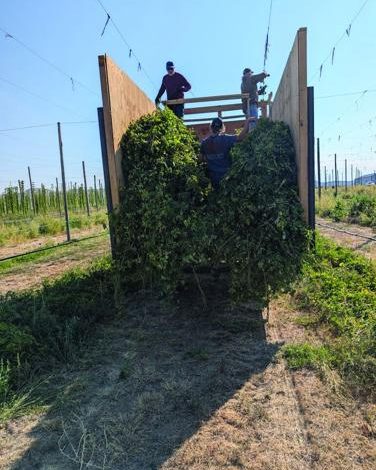Being first is thrilling — and lonely. Hillcrest Hops, tucked northeast of Worland and still the only commercial hop yard in the northern Big Horn Basin, has spent seven years learning the hard way: battling weeds, puzzling over soil quirks, and figuring out processing without the gear most growers take for granted, Casper Star-Tribune reports.
This fall, the work paid off. Owners Bill and Susan Pennington say their 2025 harvest was their best yet, tripling last year’s haul and finally hinting that their seven-acre experiment is tipping from “if” to “when.”
The rush showed up in the schedule. Harvest stretched 13 straight days — most of them 12 to 14 hours — because hop varieties ripen on their own clock and you move when they’re ready. Last year Hillcrest wrapped in nine days with a couple of breaks; this time they only stopped once, for a maintenance hiccup.
“We tripled our harvest this year, but were below our production targets,” Bill said. “We’re learning. There are not a lot of hop growers around here. I get a lot of advice from other hop growers, but they don’t have the same weather or the same soil.”
That’s an understatement. Nearly all US hops come from Washington, Idaho and Oregon, where rain does the heavy lifting and soils are different. Pennington leans on friends in Michigan’s hop scene, but their playbook doesn’t translate to Wyoming’s arid reality. Here, kochia and Canada thistle wage daily war. Irrigation is a must. And the nearest hammer mill and pelletizer — the equipment that turns delicate cones into brewer-friendly pellets — is four hours away in Bozeman. Hillcrest built its own processing shop and cold storage on the farm, but pelletizing remains the missing piece.
“They’re not cheap,” Bill said. “Pelletizing is slow and you have to be careful with heat or you ruin your hops. I want to do 100 pounds over three days, at my own pace. We need a hammer mill and a pelletizer.”
The climate, tough as it is, gives something back. Downy mildew haunts most hop yards; Hillcrest hasn’t seen it.
“Knock on wood, we have not seen any disease,” Bill said. “Everyone tells me I’m the only hop grower in the US who hasn’t. I think it’s because we’re dry.”
On varieties, Hillcrest split the difference between distinct and dependable. Two proprietary Michigan-bred hops — Mackinac™ and Michigan Copper™ — are gaining traction with Wyoming brewers, while Cascade, Centennial and Chinook cover the classics. Cascade, the citrusy backbone of American craft beer, has been an easy sell; One Eyed Buffalo has bought Hillcrest’s cones, and Ten Sleep Brewery has brewed with them, too. Centennial, famously fussy everywhere, lives up to its reputation here: lower yields, smaller cones, higher prices precisely because it’s hard to produce.
“They are just cantankerous,” Bill said, almost fondly.
The farm approach is equal parts grit and science. Hops aren’t complicated to keep alive — feed and water them — but getting them to thrive in this soil is another matter. Hillcrest samples the dirt four times a year and sends leaf tissue during the growing season to see what the plants are really hungry for. Salt is the perpetual headache, managed with sulfur and calcium to push it out of the root zone. The payoff is a yard that’s still maturing — you need about four years for hops to hit stride — and already producing beer-ready aroma and flavor.
Not every cone ends up in a kettle. Susan is experimenting with hop shoots — the spring “asparagus” of the bines — and distilling leftover cones into essential oils with floral, citrus and herbal profiles. It’s a smart side hustle in a business where equipment costs can make eyes water. When Bill first dreamed this up, he imagined 17 to 23 acres of hops. Reality — about $20,000 per acre to establish and a labor load with little automation — trimmed that ambition, at least for now. The near-term target is 1,500 pounds per acre, a benchmark he believes is within reach as the yard fully matures.
Selling remains part hustle, part timing. Wyoming counts roughly 40 breweries, and the Penningtons work the phones and the back doors, showing off samples and chasing brew days. The Wyoming Craft Brewers Guild has been in their corner. Each new beer made with Hillcrest hops is a proof point that local can work here, too.
For Bill, the reward isn’t just tonnage. It’s standing at the edge of the rows, seeing trellises heavy with cones and remembering how improbable the whole thing seemed at the start.
“We’re unique in the neighborhood and the state, really,” he said. “There’s a certain satisfaction in knowing that I’m trying, I’m giving it the old college try. And it’ll work and it’s mine and the reward is working for yourself.”









The latest news in your social feeds
Subscribe to our social media platforms to stay tuned